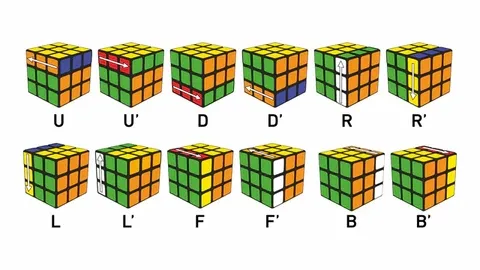Rubik's Cube: Formulas and Uses...!!!
The Rubik's Cube is one of the most popular and enduring puzzles in the world. Invented in 1974 by Hungarian architect Ernő Rubik, the cube has fascinated people of all ages and skill levels. Solving the Rubik's Cube requires understanding various algorithms or formulas that guide the movement of the cube's pieces.

Basic Structure of the Rubik's Cube
The standard Rubik's Cube consists of a 3x3x3 grid of smaller cubes, called "cubies." Each of the six faces of the cube can be rotated independently, and the goal is to align all the colors on each face. The cube's pieces are categorized as follows:
-
Center pieces: These are fixed in place and serve as a reference point for the colors of each face.
-
Edge pieces: These have two colors and are located between the center pieces.
-
Corner pieces: These have three colors and are located at the corners of the cube.
Notation for Rubik's Cube Moves
To solve the Rubik's Cube, it's essential to understand the notation used to describe the moves. Each face of the cube is labeled with a letter:
-
F: Front
-
B: Back
-
U: Up
-
D: Down
-
L: Left
-
R: Right
Each move is represented by one of these letters, indicating a 90-degree clockwise rotation of that face. A counterclockwise rotation is indicated by an apostrophe (e.g., F'), and a 180-degree rotation is indicated by the number 2 (e.g., F2).
Basic Formulas for Solving the Rubik's Cube
Solving the Rubik's Cube involves several steps, each with its own set of algorithms. Here are the basic formulas for solving a standard 3x3 Rubik's Cube:
-
Solving the First Layer
-
White Cross: Align the white edge pieces with the corresponding center pieces to form a cross on the white face.
-
Example algorithm: F R U R' U' F'
-
-
First Layer Corners: Place the white corner pieces in the correct positions.
-
Example algorithm: U R U' L' U R' U' L
-
-
-
Solving the Second Layer
-
Edge Pieces: Move the edge pieces of the second layer into place.
-
Example algorithm (for edge piece on the right): U R U' R' U' F' U F
-
Example algorithm (for edge piece on the left): U' L' U L U F U' F'
-
-
-
Solving the Last Layer
-
Yellow Cross: Form a yellow cross on the top face.
-
Example algorithm: F R U R' U' F'
-
-
Positioning the Yellow Corners: Move the yellow corner pieces into their correct positions.
-
Example algorithm: U R U' L' U R' U' L
-
-
Orienting the Yellow Corners: Rotate the yellow corner pieces to align the colors.
-
Example algorithm: R U R' U R U2 R'
-
-
Positioning the Yellow Edges: Move the yellow edge pieces into their correct positions.
-
Example algorithm: R U' R U R U R U' R' U' R2
-
-
Advanced Formulas and Techniques
For those who want to solve the Rubik's Cube more quickly, advanced techniques and algorithms are available. These methods often involve memorizing a larger set of algorithms to improve solving times. Some popular advanced methods include:
-
CFOP Method (Fridrich Method)
-
Cross: Solve the cross on the first layer.
-
F2L (First Two Layers): Solve the first two layers simultaneously.
-
Example algorithm: U R U' R' U' F' U F
-
-
OLL (Orientation of the Last Layer): Orient the last layer to have the same color.
-
Example algorithm: R U2 R' U' R U' R'
-
-
PLL (Permutation of the Last Layer): Permute the last layer pieces to complete the cube.
-
Example algorithm: R' U L U2 R U' R' U2 R L' U
-
-
-
Roux Method
-
First Block: Solve a 1x2x3 block on one side of the cube.
-
Second Block: Solve a 1x2x3 block on the opposite side.
-
CMLL (Corners of the Last Layer): Orient and permute the last layer corners.
-
Example algorithm: U R U' L' U R' U' L
-
-
LSE (Last Six Edges): Solve the remaining six edges.
-
Example algorithm: M' U M U2 M' U M
-
-
Uses of the Rubik's Cube
-
Educational Tool
-
Cognitive Development: Solving the Rubik's Cube enhances cognitive skills such as spatial reasoning, problem-solving, and memory.
-
Mathematics: The cube introduces concepts of algorithms, permutations, and combinatorics, making it a valuable teaching tool in mathematics.
-
Programming: The step-by-step logic required to solve the cube is analogous to programming, helping students develop computational thinking skills.
-
-
Mental Exercise
-
Brain Stimulation: The puzzle provides mental stimulation, helping to keep the brain active and sharp.
-
Concentration: Solving the cube requires focus and concentration, making it an effective exercise for improving attention span.
-
-
Stress Relief
-
Relaxation: Many people find the repetitive and systematic nature of solving the cube to be relaxing and therapeutic.
-
Sense of Accomplishment: Successfully solving the cube provides a sense of achievement and satisfaction, boosting mood and confidence.
-
-
Competitive Sport
-
Speedcubing: Competitive solving, known as speedcubing, has become a popular sport with its own community and competitions. Participants aim to solve the cube in the shortest time possible, with world records being in the single digits for seconds.
-
World Championships: The World Cube Association organizes official competitions and maintains records for various solving categories and techniques.
-
-
Art and Creativity
-
Mosaic Art: Rubik's Cube enthusiasts create intricate mosaic artworks using multiple cubes, arranging the colored faces to form images and designs.
-
Customization: Artists and hobbyists customize cubes with unique patterns and designs, turning the puzzle into a canvas for creative expression.
-
-
Team Building
-
Collaboration: Solving the Rubik's Cube in a group setting fosters teamwork and collaboration, as participants share strategies and work together to solve the puzzle.
-
Problem-Solving Workshops: Companies and organizations use the cube in team-building exercises to enhance problem-solving skills and encourage creative thinking.
-
-
Therapeutic Use
-
Rehabilitation: The Rubik's Cube is used in therapeutic settings to aid in cognitive and motor skill rehabilitation, particularly for individuals recovering from brain injuries or strokes.
-
Occupational Therapy: The puzzle helps improve fine motor skills, hand-eye coordination, and dexterity, making it a valuable tool in occupational therapy.
-
The Rubik's Cube is more than just a puzzle; it is a versatile and valuable tool with numerous benefits. From enhancing cognitive skills and providing stress relief to serving as an educational aid and a competitive sport, the Rubik's Cube offers something for everyone. Its enduring popularity and wide-ranging applications make it a timeless classic that continues to captivate and challenge people around the world.
What's Your Reaction?

















